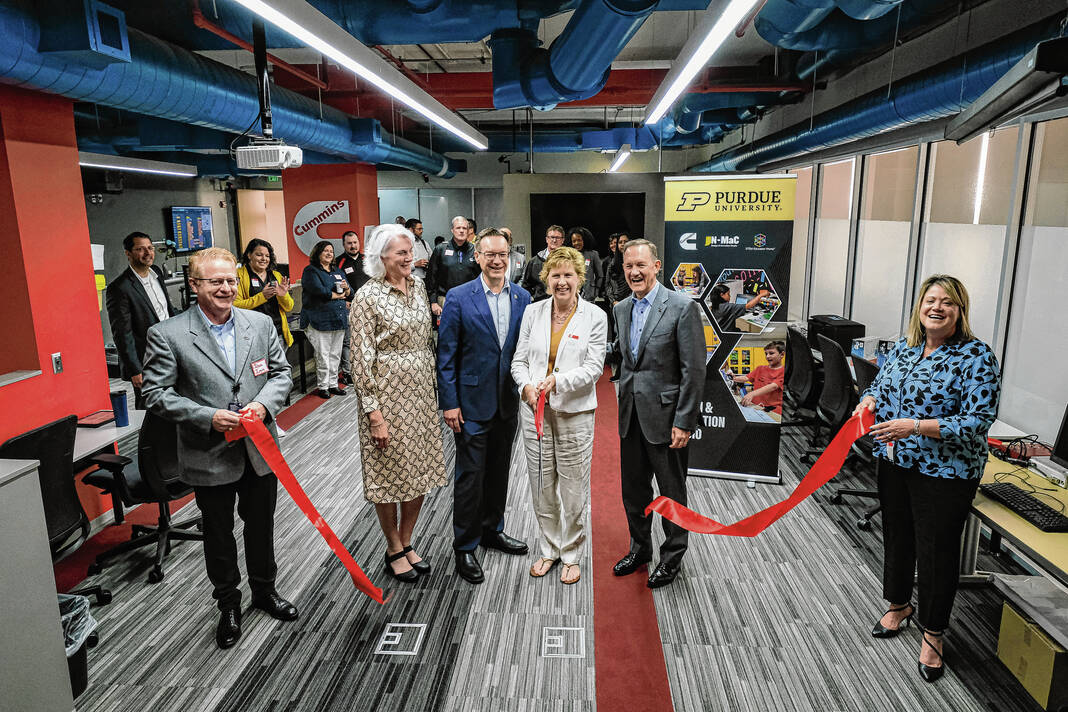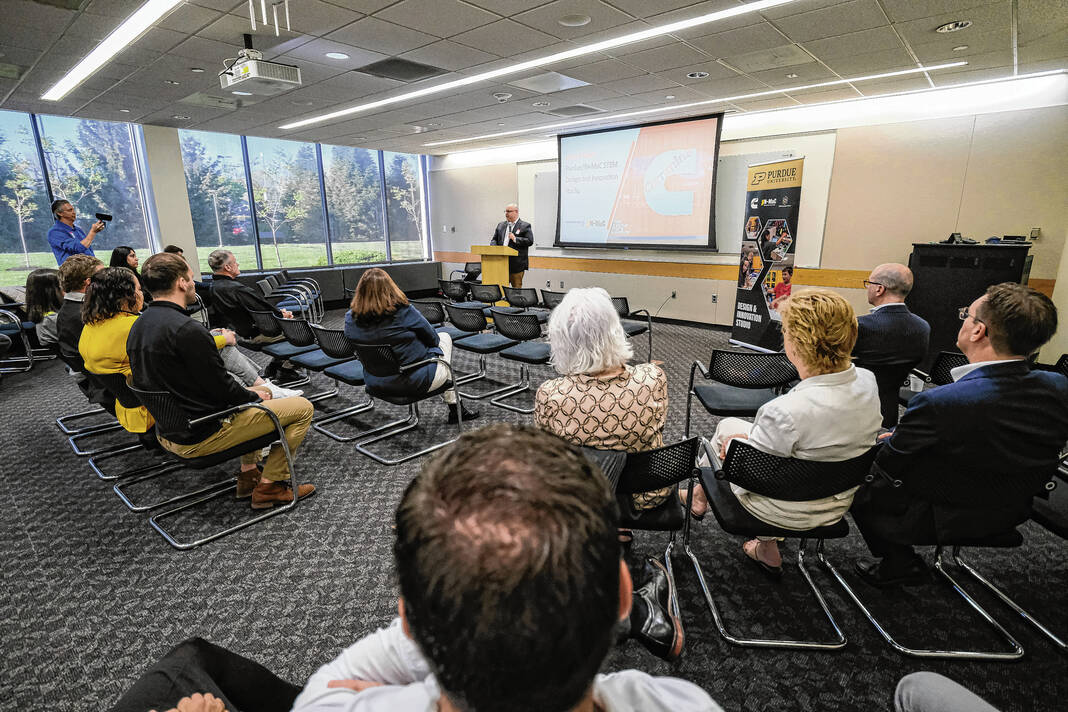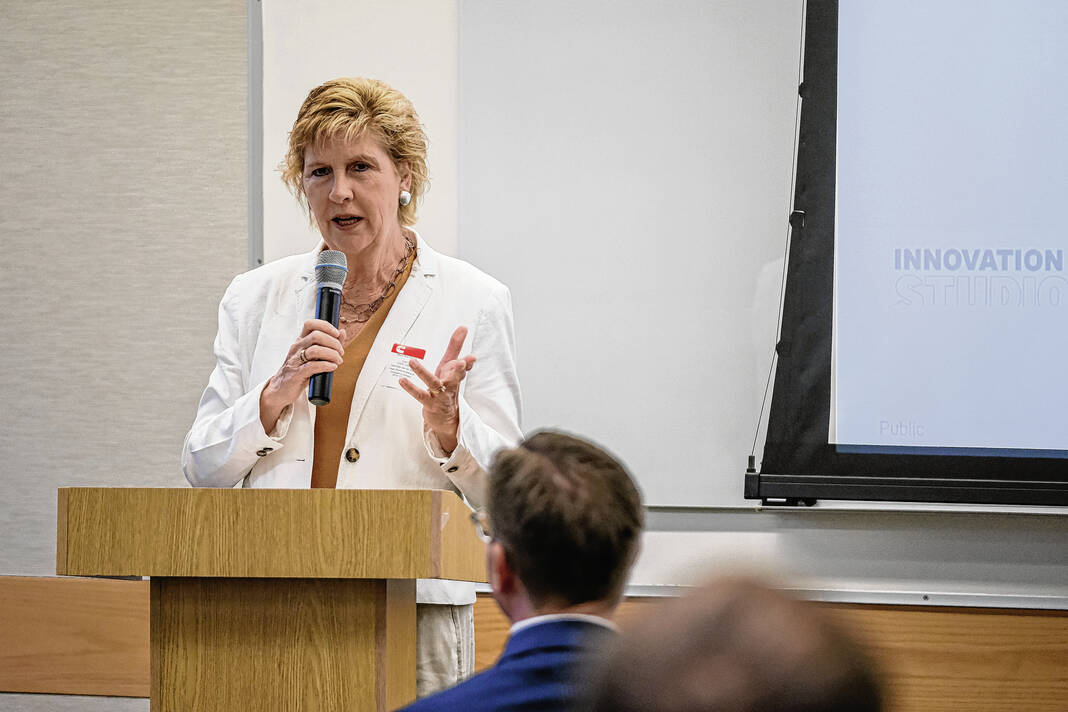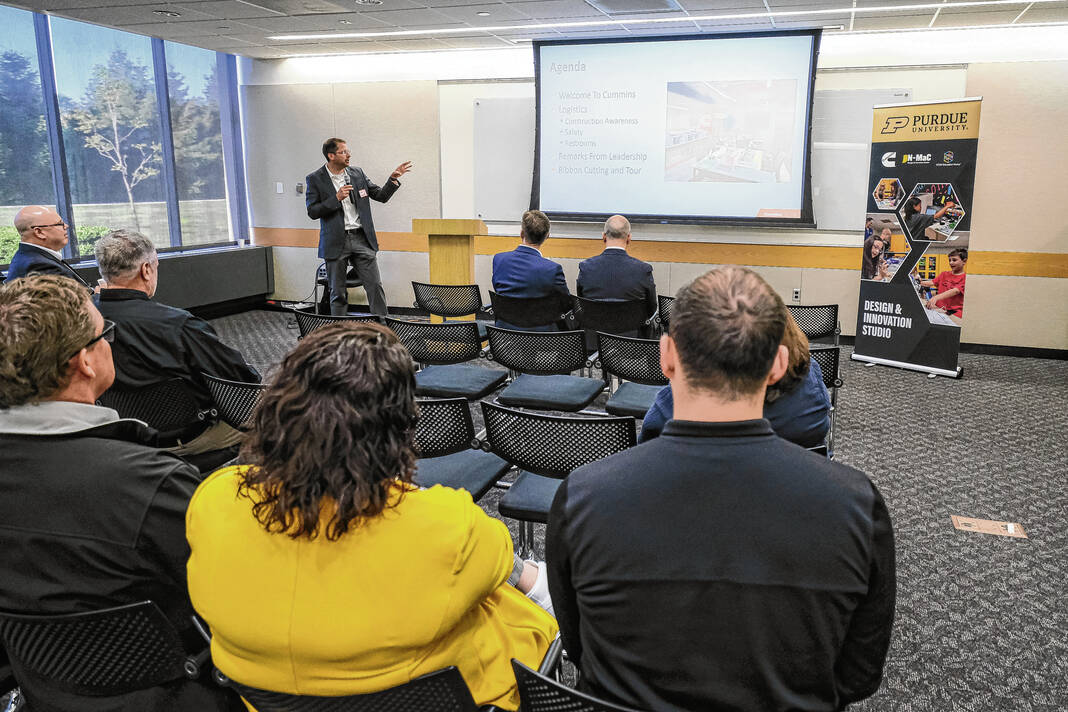
Mike Wolanin | The Republic People gather inside the Cummins and Purdue Indiana Next Generation Manufacturing Competitiveness Center at the Cummins Technical Center in Columbus, Ind., Monday, April 22, 2024.
A local high-tech space where students learn valuable STEM skills and put them to the test launched on Monday.
The Cummins and Purdue Indiana Next Generation Manufacturing Competitiveness Center’s (IN-MAC) Design and Innovation Studio is a dedicated learning space, informed by state curriculum and engineered for students K-12, that can be used to support ideas learned in the classroom.
Officials hope the studio, located at the Cummins Tech Center, will help students develop a passion for STEM fields while they are young and provide them a memorable experience to pair with learned concepts. It’s one thing for a student to hear a lesson about coding, it’s another for a student to see coding come to life as a robot arm draws a picture for them.
“Not only will it afford and provide to students STEM-specific hands on experiences and curriculum, but it will provide the same for educators as well, as they work very hard to provide our young people in our communities the skills necessary to be successful in the workforce of the future,” said Cummins Vice President Jim Schacht.
The studio is equipped with industry 4.0 technology and features additive manufacturing, such as 3D printing, robotics, coding and programming, engineering design, microelectronics and dynamic STEM learning modules.
Using the technologies in the space can sometimes feel like a game, but underneath the fun, the activities require skills that officials say will power the next generation of STEM career fields.
Representatives from Cummins, Purdue, and the city gathered to try out the some of the gadgets and discuss what opportunities the studio could afford.
Columbus Mayor Mary Ferdon said the continued economic stability of the region depends in part on having a pool of workers trained in STEM technologies that can be learned in the studio.
“We live in a competitive world globally, nationally, regionally. And in order for Indiana and Columbus to compete with other regions for employers and employees, we need to focus on what we do well, and then we need to do it better,” Ferdon said. “ … At the risk of sounding competitive myself, we want to be the best STEM city in the country and this Design and Innovation Studio will help you succeed.”
Cummins officials said they hope this summer can be used as an opportunity for educators to familiarize themselves with the space and technology and then by this fall, teachers could begin taking students to the studio on field trips.
Purdue’s Dauch Family Professor of Advanced Manufacturing Dr. Nathan Hartman, who is also co-executive director for IN-MAC, said unlike some places similar to it, the Innovation and Design Studio fits “within a formal education context.”
“They have specific curriculum, specific assessments, they have specific outcomes driven by the teachers and the students’ application of specific technologies towards, in this case, math and science learning standards,” Hartman said.
Cummins and Purdue worked with STEM Education Works to ensure what is learned in the space is in line with state curriculum standards, easy for educators to implement and complementary to the equipment installed in the studio.
Careers in STEM are expected to grow rapidly in the near future, but the challenge is keeping students interested at young age, which is why there’s additional focus on elementary-aged students, Hartman said.
“Research tells us that 92% of boys and 97% of girls potentially lose interest in STEM if they are not immersed in these subjects by the time they’re in fifth grade,” Hartman said, adding that the studio will provide interested teachers everything they would need.
“We come alongside them with technical support with easy access to equipment and equipment lists, easy access to the lessons, as well as professional development,” Hartman said. “Teachers are busy people, they have a lot to do in a classroom. And one of the last things we want them to do is have to hassle with the things we’re trying to help them with, so we’ve tried to remove as many barriers as we possibly can for their ability to use the studios and make them useful for students.”
One piece of technology in the center is a “Sphero ball,” a programmable robot ball controlled by a tablet. Younger students may use the tablet to navigate the ball through a maze. Older students may set up a competition of sorts with five Sphero balls on two teams. All would be learning about coding and tapping into their creativity, officials said.
Another is the DOBOT Magician Lite, which students can use to learn about block coding, a simplified version of coding shown visually. A scaled-back, but colorful interface on the computer controls the DOBOT arm. Young students will mostly drag and drop on the computer to operate the robot, but a button that can be clicked on shows the underlying Python coding, helping create a holistic picture of what the technology does.
What students learn is “stackable,” officials say, meaning they begin with foundational concepts and more advanced ideas are layered on top as they get older.
BCSC Director of Elementary Education Laura Hack said she expects BCSC students will begin using the space this fall.
She also said the space will help tap into what children do best.
“Children are the most innovative thinkers,” Hack said. “And if you question this, put something just out of their reach and watch them scheme, twist and even collaborate with a sibling to get what they want. I’m telling you this because if childhood is where we are the most innovative, then how does this space take us back to a place (to) encourage that innovation and have some fun?”



















